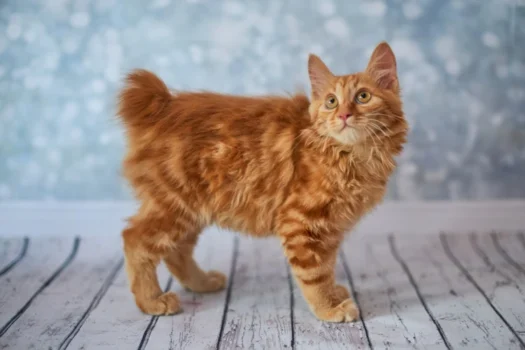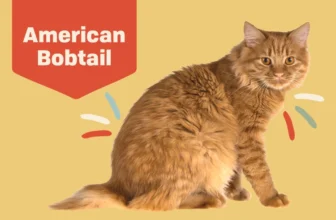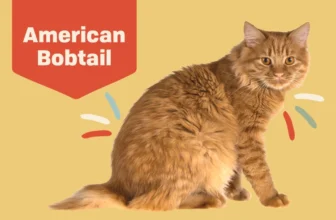Have you ever watched an American Bobtail in action? These impressive felines have a unique feature that sets them apart from other breeds: their tails. While most cats have tails that are merely used for balance, the American Bobtail’s tail plays a crucial role in their agility. But how do these tail muscles work, and how can owners train their American Bobtails to use them effectively? In this article, we’ll explore the anatomy of American Bobtail tails, their natural agility, training tips, and common issues owners may face with their tail muscles. Get ready to uncover the secrets of the American Bobtail’s impressive agility!
The Anatomy of American Bobtail Tails
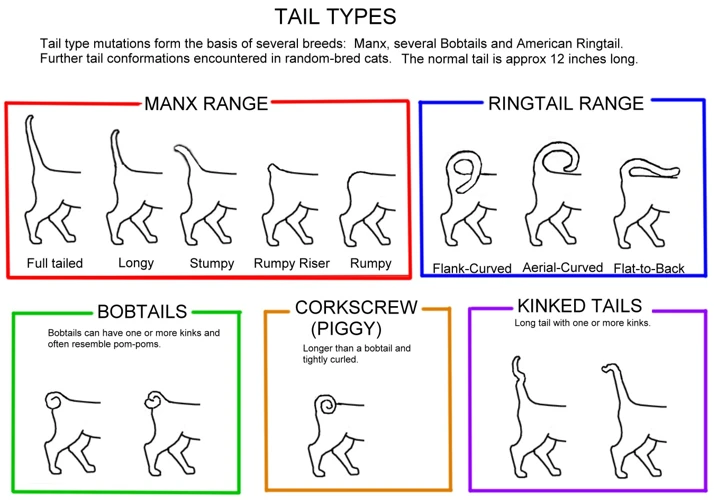
As one might expect, the tail of an American Bobtail plays a vital role in the breed’s incredible agility. However, their tails do much more than just help them navigate through intense courses. Bobtails sport unique tail anatomy, from the length to the shape, and each of these aspects contributes to their prowess. Understanding the muscles that power tail movement is only the tip of the tail, so to speak. In this section, we will dive deeper into the anatomy of American Bobtail tails and explore how it impacts their agility. Before we proceed, it might be useful to brush up on your knowledge of Bobtail tail length, shape, and balance by reading our detailed article on the tail length of American Bobtails.
The Muscles Involved in Tail Movement
The tail of an American Bobtail is a crucial aspect of their agility, and their tail muscles play an important role in its movement. There are several muscles involved in the movement of an American Bobtail’s tail.
The Lumbar Muscles
The lumbar muscles are located in the lower back of the American Bobtail. These muscles connect the tailbone with the spine, and assist in the up and down movement of the tail. Strong and flexible lumbar muscles are essential for the agility and balance of an American Bobtail.
The Coccygeal Muscles
The coccygeal muscles are located at the base of the tailbone. These muscles help in the side-to-side movement of the tail, which is important in achieving balance during agile movements. Well-developed coccygeal muscles are necessary for an American Bobtail’s ability to perform tricks and sharp turns.
The Gluteal Muscles
The gluteal muscles are located in the buttocks of an American Bobtail, and extend to the base of the tail. These muscles provide support and power to the tail, as well as contribute to the cat’s speed and agility. When strengthened through exercises, they can assist in the prevention of injuries and keep the cat’s tail movements smooth and precise.
The Tail Muscles
The tail muscles themselves are also involved in tail movement. These muscles are responsible for the curvature of the tail and affecting its length. They enable a range of motion in the tail, which contributes to the American Bobtail’s agility.
Having well-developed muscles in their tail is crucial for American Bobtails to excel in agility. However, it’s important to note that an American Bobtail’s tail comes in different shapes and sizes, and their tail and body should be in balance. To learn more about how different tail shapes and sizes affect American Bobtail agility and overall health, check out our article on tail size and balance. Additionally, proper care is crucial to maintaining the health and function of an American Bobtail’s tail. Check out our article on tail care to learn more about how to keep the American Bobtail’s tail healthy and resilient.
How These Muscles Support Agility
The American Bobtail breed is known for its agility, and the tail plays a key role in supporting their movements. Understanding how the muscles in the tail work is important for any owner of an American Bobtail interested in agility training.
The Muscles Used in Tail Movement
There are several muscles in the American Bobtail’s tail that are responsible for different movements. Here are some of the primary muscles and their functions:
| Muscle | Function |
|---|---|
| Erector spinae | Allows the tail to be lifted and lowered |
| Coccygeus | Controls lateral movement of the tail |
| Levator ani | Controls vertical movement and supports the tail muscles during intense exercise |
How These Muscles Contribute to Agility
The muscles in the tail work together with the rest of the American Bobtail’s body to create a strong and flexible base for agility movements. By lifting and lowering the tail, the erector spinae muscle helps the cat balance during jumps and sharp turns. The coccygeus muscle allows the cat to make quick side-to-side movements, which can be useful during agility courses that require weaving between obstacles. The levator ani muscle plays an important supportive role during intense exercise, helping to prevent injuries and ensuring that the cat is able to perform at their best.
Internal Link to American Bobtail Tail Evolution
It’s also worth noting that the muscles in the American Bobtail’s tail have likely evolved over time to support their agility. As discussed in our article on the evolution of American Bobtail tails, the breed has a unique genetic mutation that affects the length and shape of their tails. This mutation may have also affected the development of the tail muscles, allowing American Bobtails to excel in agility and other physical activities. Understanding the anatomy of the American Bobtail’s tail is key to unlocking their full potential as an agile and athletic cat.
Agility in American Bobtail Breeds
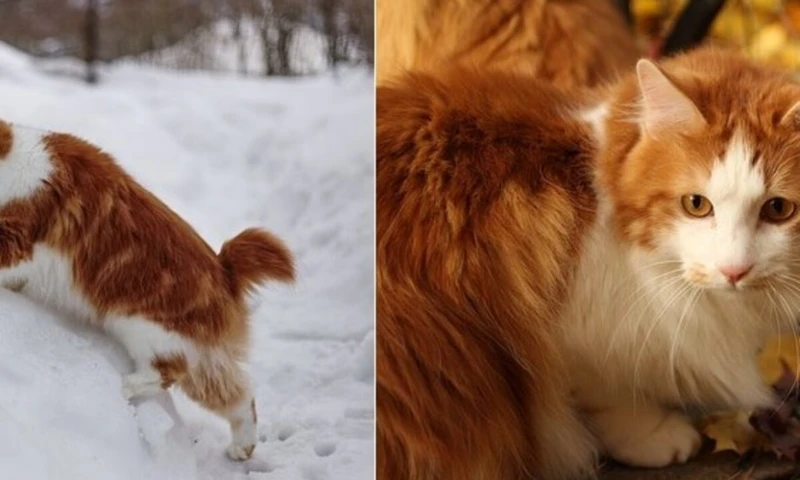
As previously discussed, American Bobtails have unique tails that set them apart from other breeds. But it’s not just their tail shape that makes them stand out; they have a natural agility that is impressive to watch. In this section, we will explore the agility of American Bobtail breeds and how their tail muscles contribute to their impressive performance. We will also delve into the history of American Bobtails in agility courses, as well as common issues to watch out for during training. So, let’s take a closer look at the athleticism of these felines.
Their Natural Agility
It is not surprising that American Bobtails are known for their exceptional agility as they possess unique qualities that enable them to perform remarkably on agility courses. These qualities are inherent in the breed, and there are a variety of reasons behind their natural agility.
Their short tail: American Bobtails have tails that are relatively shorter compared to domestic cats. This trait contributes to their balance and quick movements. As a result, they can easily maintain their posture and make sharp turns even when they are moving at high speeds.
Their strong hindquarters: The muscles in their hindquarters are powerful, giving them the strength and agility to jump, run, and climb. With this attribute, they can quickly change directions, make high jumps and leap long distances when necessary.
Their strong claws: American Bobtails have strong, sharp claws that give them an advantage in gripping surfaces when climbing, jumping or running. They use their claws to navigate surfaces when leaping, and to maintain their grip on obstacles.
These inherent qualities make the American Bobtail one of the most agile cat breeds in the world. Their excellent balance, coordination, strength, and intelligence also make them an excellent choice for agility competitions.
If you want to learn more about the meanings behind different tail shapes of bobtails, check out our article on the different tail shapes of bobtails and their meanings. Additionally, if you are interested in genetics and the bobtail gene in American Bobtails, read our article on the bobtail gene in American Bobtails.
History of American Bobtails in Agility Courses
American Bobtails have a history of excelling in agility courses, thanks to their innate physical abilities and excellent musculature. These cats are known for their powerful hindquarters and muscular tails, which allow them to balance and coordinate their movements with precision.
In the early days of cat agility competitions, the American Bobtail was not a common entrant. However, as more and more people became aware of the breed’s agility and athleticism, American Bobtails began to make their mark in the competitions.
One of the earliest recorded instances of an American Bobtail competing in an agility course dates back to the early 1990s. At a competition held in California, a 2-year-old American Bobtail named Boomer quickly charmed the judges and spectators with his speed, agility, and confidence. Despite being one of the smaller cats in the competition, Boomer’s muscular tail and powerful legs allowed him to navigate through the obstacles with ease. He ended up placing second in his division, but his performance helped to solidify the American Bobtail’s reputation as a top contender in agility courses.
Since then, American Bobtails have continued to impress in agility competitions, regularly placing in the top spots. They are known for their speed, agility, and ability to think on their feet (or paws!). Their tails play a crucial role in their performance, providing balance, stability, and coordination.
It’s worth noting that while some breeds are specifically bred for agility, the American Bobtail was not originally bred for this purpose. Their agility skills are a result of their unique musculature, combined with their natural athleticism and intelligence. This means that almost any American Bobtail can be trained to excel in agility courses, regardless of their specific bloodline.
The history of American Bobtails in agility courses is a testament to their physical abilities and natural intelligence. While they may not have been bred specifically for this purpose, their unique musculature and athleticism have made them top contenders in agility competitions for decades. If you’re interested in agility training for your American Bobtail, there’s no better time to start than now!
How Tail Muscles Contribute to Their Performance
The role of tail muscles in American Bobtail agility cannot be understated. Strong tail muscles are essential for the breed to perform at their best, as they contribute to their balance, coordination, and speed.
Here’s how tail muscles contribute to their performance:
- Balance: American Bobtails use their tail to counterbalance their body weight as they change directions, jump, and land. The tail muscles stabilize the spine and pelvis, preventing the breed from losing their balance and falling over. Without a strong tail, American Bobtails would struggle to maneuver through agility courses and perform their best.
- Coordination: The tail muscles work in harmony with the limbs and core muscles to ensure smooth movements. During an agility course, American Bobtails need to navigate through various obstacles quickly and efficiently. Their tail muscles play a crucial role in maintaining proper body positioning, allowing the breed to make swift turns and jumps.
- Speed: The tail helps American Bobtails accelerate and decelerate quickly. As the breed runs, the tail moves side to side, providing additional propulsion as it hits the ground. This extra boost of power can make a significant difference in an agility competition, allowing American Bobtails to outrun their competitors.
The tail muscles are essential for American Bobtails to reach their full potential in agility competitions. These muscles contribute to their balance, coordination, and speed, making them valuable assets for the breed. By incorporating tail muscle strengthening exercises into their training regimen, American Bobtail owners can help their pets perform at their best and avoid injuries.
Training Your American Bobtail for Agility

Preparing your American Bobtail for agility is an exciting yet challenging task, especially when it comes to strengthening their tail muscles. As a pet owner, it’s essential to know that agility training is not a one-size-fits-all approach, and different cats have different training needs. The training process requires a lot of perseverance, patience, and consistency to produce optimal results. In this section, we will take a closer look at the exercises that can help to strengthen your Bobtail’s tail muscles, and other essential training tips to improve agility.
Exercises to Strengthen Tail Muscles
When it comes to agility training for American Bobtails, exercises that focus on tail muscle strength are crucial for success. These exercises not only improve their ability to perform agile movements but also help prevent injuries. Below are some exercises that can help strengthen tail muscles in American Bobtails:
| Exercise | Description |
|---|---|
| Tail Chasing | This exercise involves encouraging your American Bobtail to chase their own tail in a safe environment. This activity can help increase tail muscle endurance and flexibility. |
| Jumping Over Obstacles | Set up a small obstacle for your cat to jump over. This movement engages the hindquarters and tail muscles and is a great way to build strength and agility. |
| Rolling | Learning how to roll can improve your cat’s coordination and balance, as well as strengthen the muscles in their tails. |
| Playing with Toys | Encourage your cat to play with a toy that requires them to use their tail, such as a feather wand. This exercise helps increase tail muscle strength, and additionally, helps develop focus and hand-eye coordination. |
It’s important to remember, like with any exercise, to start slowly and build up endurance gradually. One way to incorporate these exercises into your cat’s routine is to set aside a specific time for play and focus on different exercises each day of the week. This helps avoid overworking any muscles, including the tail.
In addition to these exercises, nutrition also plays a crucial role in keeping your American Bobtail in optimal condition for agility training. A well-rounded diet that includes high-protein and vitamin-rich foods can help maintain strong muscles and promote overall body health.
Other Training Tips for Improving Agility
Improving agility in American Bobtails goes beyond just strengthening the tail muscles. Here are some other training tips that can help improve your feline companion’s agility:
| Training Tip | Description |
|---|---|
| Start Early: | Starting your American Bobtail’s agility training as early as possible can help them develop their skills more quickly and efficiently. |
| Use Positive Reinforcement: | Rewarding your cat with treats or praise for successfully completing an agility course can encourage them to continue the behavior. |
| Keep Sessions Short: | Agility training sessions should be kept short and frequent to prevent your cat from becoming overwhelmed or bored. |
| Use Variety: | Varying the obstacles and course designs can help keep your American Bobtail mentally stimulated and prevent them from becoming bored or disinterested. |
| Stay Patient: | Agility training can take time and patience. Keep in mind that each cat is different and will progress at their own pace. |
By incorporating these training tips into your American Bobtail’s training regime, you can help improve their agility and overall performance in agility courses. Remember to always take your cat’s safety into account and consult with a veterinarian if you have any concerns.
Common Issues with Tail Muscles in American Bobtails
As with any physical activity, there are risks involved with agility training for American Bobtails. In this section, we will explore some of the common issues that can arise with their tail muscles. These issues range from minor strains to more serious injuries that may require veterinary attention. It is important for cat owners to be familiar with these potential issues so they can be watchful for any signs of discomfort or pain in their pet. Let’s take a closer look at some of the possible issues that may arise with American Bobtail tail muscles during agility training.
Injuries to the Tail
Tail injuries are quite common in American Bobtails that are involved in agility training. Some injuries can be mild, while others can be severe and may require medical attention. There are several factors that can contribute to tail injuries in American Bobtails, including overuse, incorrect posture, and accidents during training.
Overuse of tail muscles can lead to sprains and strains, which can cause discomfort and pain to the cat. If the cat is not allowed enough rest between training sessions, they may experience chronic stiffness and soreness in their tail muscles.
Incorrect posture is another cause of tail injuries in American Bobtails. If the cat is not using their tail correctly during training, it can put unnecessary strain on their muscles and ligaments, leading to pain and discomfort.
Accidents during training can also cause tail injuries in American Bobtails. For instance, if the cat jumps too high and lands awkwardly or misjudges a jump and hits an obstacle, they may injure their tail. Similarly, if the cat overextends their tail while running, they may cause a muscle strain or sprain.
To avoid injuries to the tail, it is essential to warm up and stretch the cat’s tail muscles before training. Encourage your American Bobtail to move their tail in different directions and hold each position for a few seconds to help them loosen up.
It is also crucial to provide your cat with plenty of rest between training sessions to ensure that their tails have ample time to recover. Training sessions should be short, with plenty of breaks in between, to prevent overuse of the muscles.
If your cat does experience a tail injury, it is crucial to seek veterinary care as soon as possible. Tail injuries can be quite serious, and failing to treat them promptly can cause long-term damage to the cat’s tail and health.
Injuries to the tail can occur in American Bobtails involved in agility training due to overuse, incorrect posture, and accidents during training. Preventing these injuries requires proper warm-up, rest periods between workouts, and prompt medical attention if an injury occurs.
How To Avoid Injuries to the Tail During Agility Training
During agility training, it’s important to take steps to avoid injuries to the tail in American Bobtail cats. Here are some tips to keep in mind:
| Tip #1: | Avoid training on hard surfaces. Jumping and landing on hard surfaces can put strain on the tail and lead to injuries. Stick to softer surfaces like grass or mats when possible. |
| Tip #2: | Take breaks as needed. Rest is important for preventing fatigue and avoiding overexertion, which can lead to muscle strains in the tail. |
| Tip #3: | Start with gentle exercises. At the beginning of your training, focus on low-impact exercises that gradually build up strength in the tail muscles. This will reduce the risk of injury. |
| Tip #4: | Use proper technique. When performing agility exercises that involve the tail, make sure you are using proper form and technique to avoid straining or injuring the tail. |
| Tip #5: | Monitor your cat’s behavior. If your American Bobtail appears to be in discomfort or pain during training, stop immediately and check for any signs of injury. |
| Tip #6: | Consult with your veterinarian. If you have any concerns or questions about your cat’s tail health during agility training, talk to your veterinarian for advice and guidance. |
By following these tips, you can help prevent injuries to the tail muscles and ensure that your American Bobtail remains healthy and agile during agility training. It’s important to always prioritize your cat’s safety and well-being.
Other Possible Injuries to Watch Out For
As with any intense physical activity, there are a number of possible injuries that American Bobtails may be at risk of while engaging in agility. It’s important for owners and trainers to be aware of these risks in order to prevent them from occurring, or to address them early on before they become more serious.
One possible injury is a sprained tail. This can occur when the tail is pulled or twisted in an unnatural way, causing damage to the ligaments that support it. Symptoms may include swelling, pain, and difficulty moving the tail.
Another potential issue is tail muscle strain. This can happen when the muscles in the tail are overworked and become fatigued or damaged. Symptoms may include tenderness or stiffness in the tail, as well as difficulty moving it.
American Bobtails may also be at risk of tail nerve damage. This can occur if the tail is compressed or pinched, or if there is trauma to the tail. Symptoms may include pain, numbness, or weakness in the tail.
Lastly, tail fractures are a possibility. This can happen if the tail is hit or slammed forcefully, causing a break or fracture in one or more of the tail bones. Symptoms may include pain, swelling, and difficulty moving the tail.
To prevent these injuries, it’s important to make sure that American Bobtails are properly trained and warmed up before engaging in agility activities. Owners and trainers should also be aware of their cat’s limits, and avoid pushing them too hard or too quickly. If an injury does occur, prompt treatment and rest may be necessary to allow for proper healing.
| Injury | Symptoms |
|---|---|
| Sprained tail | Swelling, pain, difficulty moving tail |
| Tail muscle strain | Tenderness, stiffness, difficulty moving tail |
| Tail nerve damage | Pain, numbness, weakness in tail |
| Tail fractures | Pain, swelling, difficulty moving tail |
Conclusion
In conclusion, understanding the role of tail muscles in American Bobtail agility is essential for pet owners interested in training their cat for this activity. The tail muscles of American Bobtails play a significant role in their agility and overall athleticism. It is important to note that American Bobtails are naturally agile cats, but with proper training and exercise, their agility can be improved even further.
Pet owners interested in training their American Bobtail for agility should consider exercises that specifically target the cat’s tail muscles. These exercises can include tail lifts and curls, as well as using agility equipment that requires the use of the tail for balance.
However, it is crucial to ensure that kittens have fully developed tail muscles before introducing them to any agility training. Additionally, pet owners should be aware of the potential for tail injuries during agility courses, which can be prevented by taking necessary precautions.
In any case, American Bobtails are a fantastic breed for agility training, thanks in large part to their unique tail anatomy. These cats are not only athletic but also intelligent and have the ability to learn and excel in agility courses. With proper training and care, American Bobtails can become excellent agility partners and loving companions. So, if you’re a pet owner interested in taking your feline’s athleticism to the next level, American Bobtails are definitely worth considering!
Frequently Asked Questions
What is the role of tail muscles in American Bobtail agility?
The tail muscles play a crucial role in American Bobtail agility as they help with balance, flexibility, and control during rapid movements and turns.
How many tail muscles do American Bobtails have?
American Bobtails have a total of about 20 small tail muscles that work together to provide support and movement.
What is the natural agility of American Bobtails?
American Bobtails are known for their natural agility, as they have a strong and muscular body that allows them to jump, climb, and run with ease.
Can American Bobtails compete in agility courses?
Yes, American Bobtails are highly regarded in agility competitions, and they have a long and impressive history of success in the sport.
Which tail muscles are the most important for agility?
The tail muscles that are most crucial for agility are the ones located at the base of the tail, which provide stability and allow for quick movements and turns.
Can tail muscle injuries occur during agility training?
Yes, tail muscle injuries can occur during agility training, especially if the cat is overexerted or if a maneuver is performed incorrectly.
What are some exercises to strengthen tail muscles?
Exercises such as chasing toys, climbing, and jumping can help strengthen tail muscles in American Bobtails.
What other training tips can help improve American Bobtail agility?
Practicing regularly and using positive reinforcement can help improve American Bobtail agility, as can engaging in activities that require them to use their tails, such as playing with toys on strings.
What are some common injuries to watch out for in American Bobtails?
Injuries to the tail, such as sprains or fractures, are the most common injuries in American Bobtails. However, other injuries, such as muscle strains and sprains, can also occur.
How can injuries to the tail be avoided during agility training?
To avoid tail injuries during agility training, it is important to start with basic maneuvers and gradually increase the difficulty level, as well as to provide plenty of rest and recovery time between sessions.

